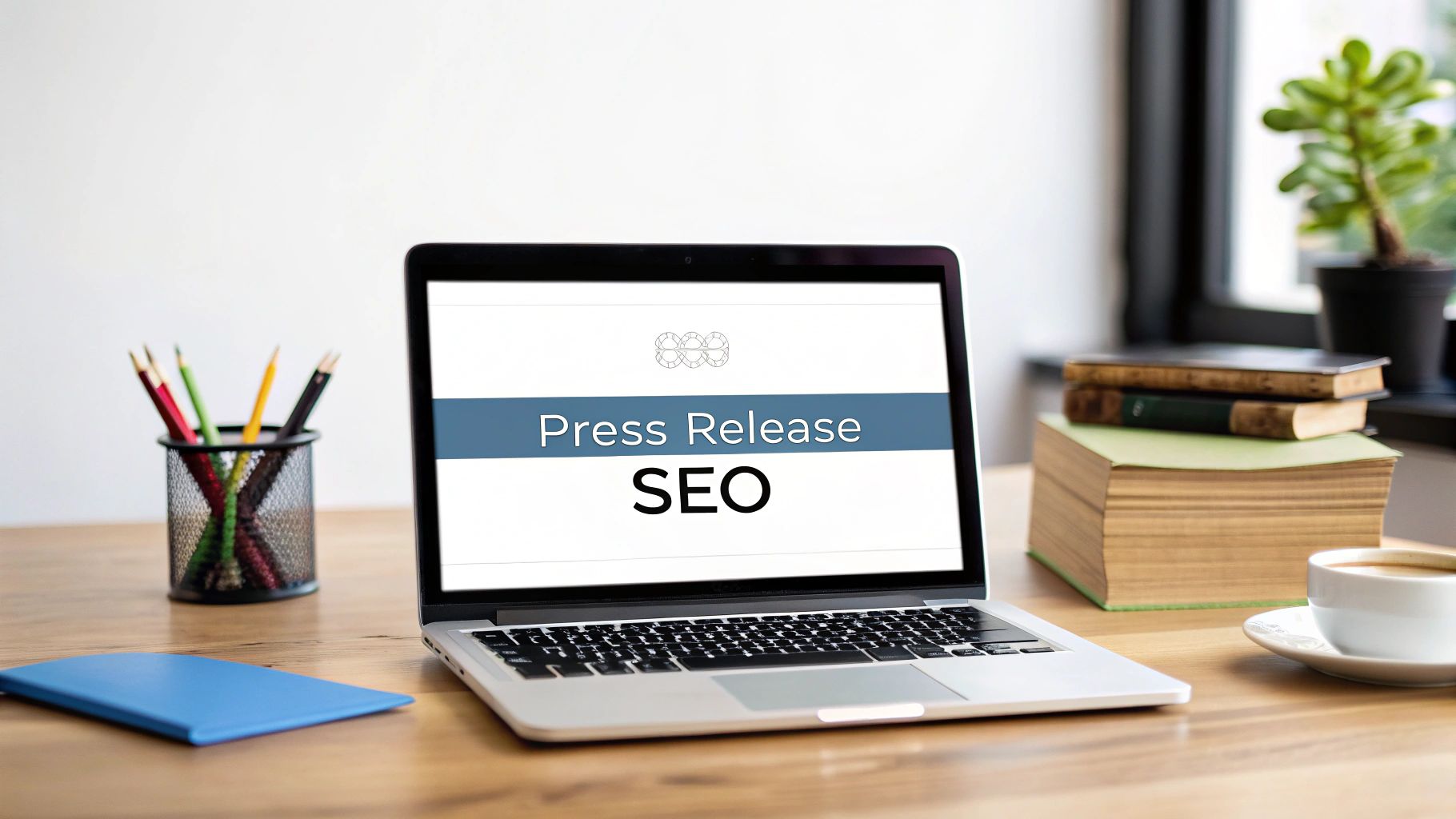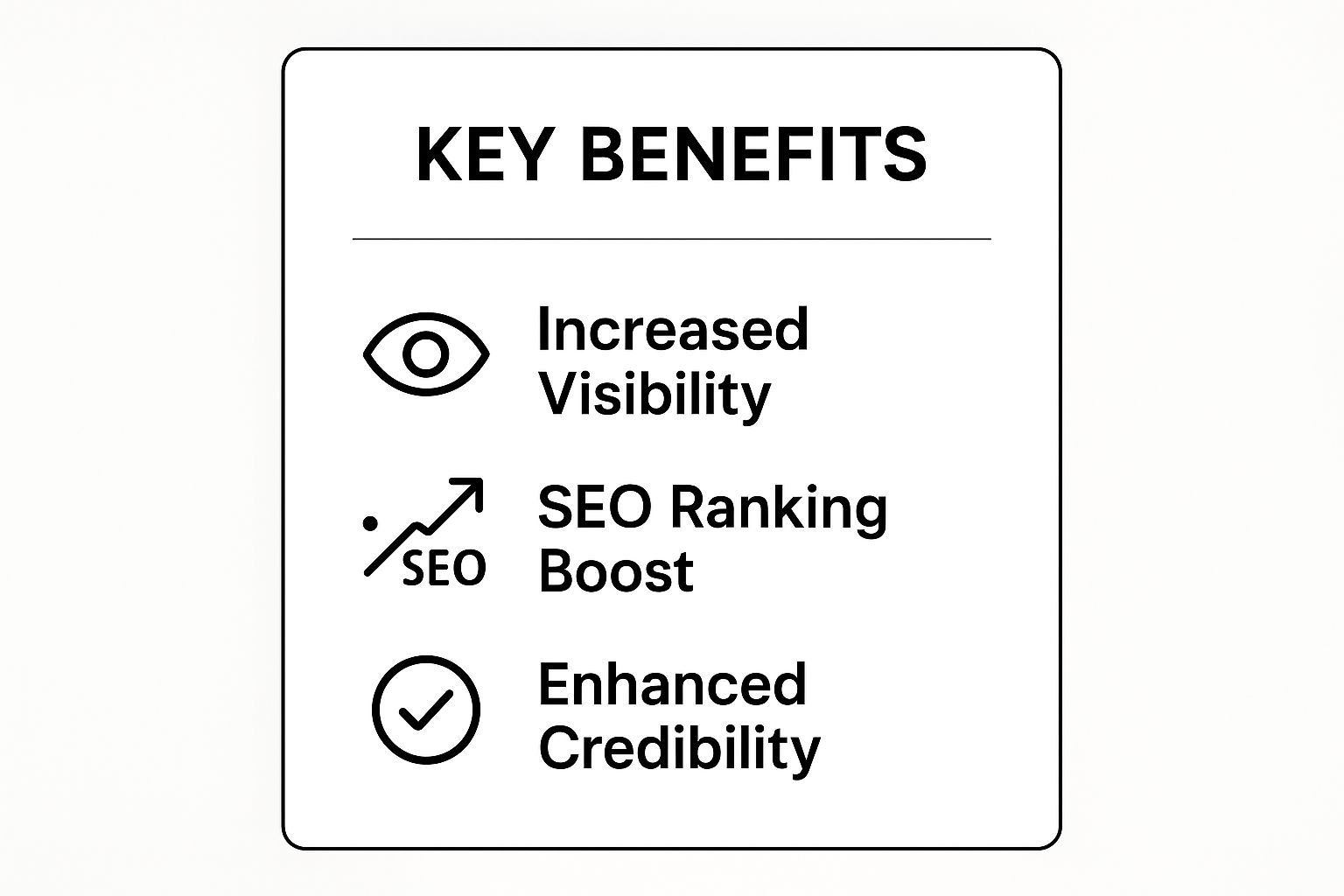
Press Release SEO: Boost Your Search Rankings Now
The Evolution of Press Release SEO in Modern Marketing

The press release was once a simple announcement, a straightforward way to share company news. But the online world has transformed it into something much more: a powerful tool for building online presence. Now, press releases must not only inform journalists but also speak to search engine algorithms. This marks a significant shift in how brands in the UK connect with the media.
The Rise of Digital PR in the UK
Press release SEO, a core component of Digital PR, is more important than ever. This strategy blends SEO best practices with traditional PR, empowering businesses to improve search engine rankings and connect with a broader audience. Optimizing press releases with relevant keywords, for instance, helps search engines understand and rank content for users seeking that specific information. This gives brands control over their story, ensuring their message is front and center when potential customers or investors are searching online.
This SEO-focused shift in PR is evident in the growing interest among UK businesses. Since 2020, searches related to Digital PR have increased by a remarkable 49% among UK businesses. While current adoption of off-page SEO (which includes Digital PR) stands at 36% among UK businesses as of 2025, the rising cost of paid advertising is pushing more businesses towards organic, content-driven visibility. A 2025 Neil Patel survey further revealed that 44% of marketers plan to boost their SEO budgets. Press releases are now crafted with keyword targeting and backlink acquisition in mind, highlighting the increasing convergence of PR and SEO. For more insights, explore these statistics: Explore this topic further
From Traditional Tactics to SEO Integration
Traditional press release strategies often focused solely on gaining media coverage. This approach, however, can miss out on the potential for broader online visibility and engagement. SEO-integrated press releases, in contrast, are designed with both journalists and search engines in mind. The result? Announcements that not only earn media mentions but also attract organic traffic, elevate search rankings, and strengthen brand credibility.
Today's leading brands understand the power of balancing newsworthiness with strong search performance. By strategically integrating relevant keywords and optimizing multimedia, brands can amplify their message far beyond traditional channels. This broader reach allows them to connect with a wider audience and achieve their marketing goals more effectively. This integrated approach has become essential for successful PR strategies, driving measurable results and strengthening brand presence in the competitive digital landscape.
Essential Elements of High-Performing SEO Press Releases

This summary box highlights the key elements of a high-performing SEO press release, emphasizing compelling headlines, semantic keyword research, multimedia integration, and technical SEO. As you can see, these elements work together to create a press release that resonates with both search engines and journalists.
Imagine your press release reaching not just journalists but also a vast audience searching online for news just like yours. That's the power of press release SEO. This section explores the essential components that elevate your press release from overlooked to highly visible.
Crafting Compelling Headlines for SEO and Journalists
A captivating headline is your first impression. It needs to grab the attention of journalists scanning numerous releases while also incorporating relevant keywords for search engines like Google. Think of it as a bridge connecting your news with your audience. For example, crafting a headline with a number or a question can pique readers' curiosity, drawing them in for more. Keep it concise, focusing on the core message, and watch your engagement soar.
The Power of Semantic Keyword Research
True semantic keyword research delves deeper than just your primary keyword. It's about understanding the language surrounding your topic. Imagine your press release is about a new electric vehicle. Semantic keywords might include "sustainable transportation," "eco-friendly cars," or "zero emissions." By incorporating these related terms, you're painting a richer picture for search engines, increasing the chances of your press release appearing in relevant searches.
Multimedia Integration for Enhanced Engagement
A picture is worth a thousand words, and a video? Even more. Integrating multimedia like images and videos doesn't just make your press release visually appealing; it adds layers of engagement and SEO benefits. Optimized images with alt text and videos with descriptions provide further opportunities to weave in those valuable keywords. Plus, engaging content is more likely to be shared, amplifying your reach and boosting your SEO efforts.
Formatting, Structure, and Technical SEO
A well-structured press release is a reader's best friend. Short paragraphs, bullet points, and subheadings make information easily digestible, enhancing readability and SEO. Think of it as creating a clear path for both readers and search engines to navigate your message. Technical elements like schema markup, a code that helps search engines understand your content, can further elevate your press release's visibility.
To help you implement these strategies effectively, here’s a handy checklist you can use:
Press Release SEO Checklist
Essential optimisation elements for search-friendly press releases
| Optimisation Element | Best Practice | Impact on SEO |
|---|---|---|
| Compelling Headlines | Incorporate relevant keywords while keeping it concise and engaging. Use numbers or questions to pique interest. | Improves click-through rate and attracts journalists. |
| Semantic Keyword Research | Identify and include related terms and phrases beyond your primary keyword. | Enhances search engine understanding and relevance. |
| Multimedia Integration | Use high-quality images with optimized alt text and videos with descriptions. | Boosts engagement and provides more keyword opportunities. |
| Technical SEO | Implement schema markup and ensure proper formatting with short paragraphs, bullet points, and subheadings. | Improves readability and search engine visibility. |
This checklist summarizes the key optimization elements and their impact on your press release’s visibility. By following these best practices, you can significantly improve your chances of reaching a wider audience.
These elements work together to create a powerful press release, optimized for search engines while maintaining journalistic integrity. This synergy leads to greater visibility and increased engagement, but remember, the heart of a successful press release lies in its genuine value. We'll explore this further in the next section.
Balancing Journalistic Value With Search Performance

Creating SEO press releases will help you rank on Google. It's a delicate balancing act. The challenge? Creating content that appeals to both journalists and search engines. This means crafting compelling narratives that resonate with human readers while strategically incorporating elements that boost search visibility. This section will guide you in mastering this balance, maximizing the impact of your press releases.
Frameworks for Natural Keyword Integration
Keyword integration is crucial for press release SEO. However, keyword stuffing can make your press release sound robotic and unnatural. Instead, focus on naturally incorporating keywords within your writing.
For example, if your press release is about a new sustainable packaging solution, instead of repeatedly using "sustainable packaging," explore synonyms like "eco-friendly packaging" or "environmentally responsible packaging." This approach ensures readability while targeting relevant search terms and provides a more nuanced, informative experience for readers.
Aligning Editorial Calendars With Search Trends
Planning ahead is key. Aligning your editorial calendar with trending search terms ensures your releases are timely and relevant. This involves conducting keyword research to identify trending topics.
Consider using tools like Google Trends to anticipate spikes in search interest around specific events or holidays. By staying ahead of the curve, your press releases address current public interests, increasing the chances of media pickup and reader engagement.
Case Studies: Over-Optimization vs. Strategic Optimization
Success often hinges on your SEO approach. Case studies reveal that over-optimized press releases, stuffed with unnatural keywords and spammy links, are often rejected by media outlets. Conversely, releases with a strategic approach, balancing keywords with compelling narratives, generate significant coverage and improve search visibility.
One example involves a tech startup whose over-optimized press release was rejected by multiple tech blogs. Prioritizing storytelling and natural keyword integration in a revised release led to coverage in leading publications and a noticeable increase in organic traffic.
Practical Templates and Exercises
Practical application is essential. Developing templates for press release creation ensures consistency and efficiency in your messaging. These templates can include designated spaces for keyword integration, multimedia, and targeted calls to action.
Exercises focusing on compelling headlines and engaging leads can strengthen your ability to capture attention. By combining these efforts, you create press content that resonates with readers while also meeting the technical requirements of search engines, maximizing your reach.
Strategic Distribution for Maximum Search Impact
Imagine crafting the perfect press release, meticulously optimized and brimming with potential. Yet, without a robust distribution strategy, its impact might be disappointingly limited. This section explores how to distribute your press release for maximum reach and resonance, focusing on engaging journalists and enhancing your press release SEO.
Targeted Outreach vs. Mass Distribution
It's tempting to cast a wide net and distribute your press release to every corner of the internet. However, targeted outreach is akin to planting seeds in fertile ground, nurturing growth and yielding far richer results. This approach involves connecting with journalists and publications specifically relevant to your industry. Personalization is key, fostering genuine engagement and increasing the likelihood of media pickup and valuable backlinks. Mass distribution, conversely, often resembles scattering seeds on barren land, resulting in minimal SEO benefit and a scattering of low-quality backlinks – or none at all.
Evaluating Distribution Partners: Beyond Vanity Metrics
Selecting the right distribution partner is paramount to your press release's success. Don't be swayed by superficial metrics like subscriber counts. Instead, delve deeper into more meaningful criteria. Domain authority is a crucial factor, signifying a website's influence and trustworthiness in the eyes of search engines. Partnering with a high-domain-authority platform significantly amplifies your release's visibility. Equally important is the strength of their syndication networks. A robust network ensures broader reach, expanding your online presence and increasing opportunities for valuable backlinks.
Timing Your Press Release for Maximum Visibility
Strategic timing can significantly enhance your press release's impact. Consider both journalist workflows and search engine algorithms. Submitting your release early in the week, preferably Monday or Tuesday morning, aligns with journalistic deadlines, increasing the chances of it being noticed before the week's rush consumes their attention. Aligning your release with relevant news cycles or industry events can also boost its relevance and timeliness, capturing attention and increasing the likelihood of media pickup. For example, understanding how to strategically cloak a link for SEO can further elevate your strategy. This thoughtful timing resonates with both journalists and search algorithms, adding a layer of relevance that sets your release apart.
Paid vs. Organic Distribution: Finding the Right Balance
Both paid and organic distribution hold unique value in a successful press release strategy. Paid distribution offers immediate reach and visibility through established networks, proving particularly beneficial for time-sensitive announcements or significant product launches. Organic distribution, on the other hand, focuses on cultivating relationships with journalists, earning media coverage through compelling narratives and targeted outreach, building credibility, and fostering valuable backlinks. Often, a combination of both approaches yields the best results. Carefully evaluate your budget and objectives to strike the perfect balance.
Building Media Relationships for Long-Term Success
Building strong relationships with journalists transforms your press content from unwanted solicitations into valuable editorial resources. Journalists serve as gatekeepers to your target audience. By consistently providing them with relevant, well-written, and timely content, you establish yourself as a trusted and reliable source. This fosters trust and increases the likelihood of future coverage. Personalize your outreach, demonstrate genuine interest in their work, and offer exclusive insights or data. These efforts create a ripple effect, turning journalists into advocates for your brand and generating consistent media coverage and valuable backlinks, solidifying your position as a trusted source for future news.
To help you decide on the optimal distribution channel for your press release, the following table summarizes the key features of some popular methods:
To help you navigate the diverse landscape of press release distribution, let's delve into a comparison of various channels and their SEO effectiveness.
Press Release Distribution Channels Comparison
| Distribution Channel | SEO Benefits | Cost Range | Best For |
|---|---|---|---|
| Newswire Services (e.g., PR Newswire) | Wide reach, high domain authority, potential for strong backlinks | $$$ | Large companies, major announcements |
| Targeted Media Outreach | Highly relevant backlinks, builds relationships with journalists | $-$$ | Building brand credibility, niche industries |
| Social Media Promotion | Increased visibility, drives traffic to your website | $ | Engaging your audience, building brand awareness |
| Owned Media (e.g., Your Website) | Control over messaging, foundation for other distribution efforts | $ | Building a central hub for your news |
This table highlights the distinct strengths of each distribution channel, allowing you to tailor your approach based on your specific needs and resources. While newswire services offer extensive reach, targeted media outreach builds valuable relationships. Social media expands visibility and engagement, while owned media provides a central hub for your news.
By considering these diverse approaches, you can orchestrate a distribution strategy that maximizes your press release's impact, reaching your target audience and boosting your SEO efforts.
Measuring True Press Release SEO Performance

Measuring the true impact of your press release SEO strategy involves more than just counting how many press releases you've distributed. It's about understanding the real search visibility your press releases are generating. It's about recognizing the tangible value your PR efforts bring.
Beyond Vanity Metrics: Evaluating Genuine Impact
Many assess press release success using vanity metrics. These numbers might look good at first glance, but they often don’t tell the whole story. A large number of placements on low-authority sites doesn't automatically translate into higher search rankings or increased organic traffic.
Instead, focus on metrics that directly impact your search visibility. Key Performance Indicators (KPIs) like organic traffic growth, backlink quality, and conversions offer a more accurate view of your press release's performance. These KPIs connect directly to your business goals, demonstrating the real value of your PR work. By analyzing these KPIs, you gain practical insights to refine your strategy for optimal results.
Configuring Attribution Models for Press Release SEO
To connect your press release activities with website performance, you need precise attribution modelling. This means setting up your analytics platform (like Google Analytics) to track how press releases contribute throughout your marketing funnel.
Using UTM parameters in your press release links lets you track referral traffic, conversions, and even revenue generated from each placement. Tagging your links gives you valuable data on how press releases influence user behavior. This information helps you fine-tune your strategy, focusing on the most impactful elements.
Tools and Techniques for Tracking Backlink Quality
Backlinks from press releases are essential for boosting your website's search ranking. But the quality of these backlinks matters significantly. Domain authority, relevance, and anchor text diversity are key factors that determine a backlink's true value.
Tools like Ahrefs and SEMrush allow you to analyze backlink quality. This data helps you make informed decisions about your PR strategy. By identifying authoritative websites in your industry, you can target placements that deliver truly valuable backlinks, increasing your search visibility.
Dashboard Setups and Benchmark Data
A clear, concise dashboard that visualizes your key press release SEO metrics is crucial. This dashboard should track KPIs like organic traffic, referral traffic from press releases, backlink quality, and conversions. This information helps you communicate progress to stakeholders and spot areas for improvement.
Comparing your performance to industry benchmarks gives you context and helps you assess your strategy's effectiveness. By analyzing how your metrics compare to your competitors, you can pinpoint your strengths and weaknesses. This data-driven approach empowers you to continually refine your strategy and stay ahead of the game.
Advanced Press Release SEO Techniques That Deliver Results
Press release SEO isn't just about keywords anymore. It's about connecting with your audience in a meaningful way and giving search engines the information they crave. This section explores cutting-edge techniques to boost your search visibility and deliver tangible results, especially for UK-based businesses. We'll uncover how structured data markup, entity optimization, and multimedia enhancements can transform your press release performance.
Structured Data Markup: Getting Featured
Structured data markup is like a secret language you can use to speak directly to search engines. It's a specialized code that helps them understand the context of your content. By adding this markup, search engines can present your press release information in engaging formats like featured snippets and news carousels. Imagine highlighting the most important parts of your press release for Google to showcase directly on the search results page. This increased visibility translates to higher click-through rates and more people reading your news. The good news? Even non-technical teams can implement basic schema markup with user-friendly online tools and generators.
Entity Optimization: Moving Beyond Keywords
Keywords are still important, but entity optimization takes things a step further. It's about focusing on the who, what, and why of your news. Instead of just targeting keywords, you're highlighting the people, organizations, and concepts relevant to your announcement. For example, if your press release is about a new partnership with a Fintech company, you'd optimize for entities like the company name, its CEO, and relevant industry terms like "financial technology" or "open banking." This helps Google understand the bigger picture, leading to better targeting and higher rankings for relevant searches.
Multimedia Optimization: Visual Search Power
Images and videos are powerful tools for capturing attention and conveying information. Optimizing your multimedia elements is crucial for visual search. Make sure your images have descriptive alt text and file names that include relevant keywords and entities. Similarly, add captions and transcripts to your videos to give search engines the context they need. By optimizing your visuals, you increase the chances of your press release appearing in image and video searches, extending your reach beyond traditional text-based results.
Localization: Dominating Regional Search
For UK-based businesses, localization is key to reaching the right audience. Incorporate region-specific keywords and language into your press release. Think about the nuances of British English and the terms your target audience uses. For instance, "Managing Director" might resonate more than "CEO" in certain contexts. Mentioning specific UK locations or referencing local events can also boost your relevance to UK searchers, helping you dominate regional search results and connect with your local audience.
Case Studies: Innovative Press Release SEO
Many brands are seeing incredible results by embracing innovative press release optimization strategies. One example is a UK fintech startup that used structured data markup, specifically FAQ schema, to secure a featured snippet for a key industry term. By answering common user queries directly on the search results page, they significantly increased organic traffic. This demonstrates the power of thinking outside the box and applying advanced techniques to achieve exceptional results in the competitive online world.
Avoiding Critical Press Release SEO Mistakes
A well-optimized press release can significantly boost your brand’s visibility and online presence. It’s a powerful tool for sharing your story and connecting with a wider audience. However, even with the best intentions, common SEO mistakes can undermine your efforts. This section explores these pitfalls and provides actionable advice to avoid them, ensuring your press releases reach their full potential and make a lasting impact.
Over-Optimization: A Recipe for Disaster
Over-optimization, like keyword stuffing, can trigger penalties from search engines like Google and alienate journalists. Think of it like adding too much spice to a delicate dish – it overwhelms the flavor and ruins the experience. Focus on natural language and compelling storytelling. For example, a software company, eager to rank for "project management software," overused the keyword, making their press release sound unnatural and spammy. The result? Journalists dismissed it, and search engines penalized the website. The key takeaway is to write for humans first, search engines second.
Duplicate Content: The Wire Service Trap
Distributing the same press release across numerous wire services without modification creates duplicate content issues. Search engines struggle to determine the original source, diluting your SEO efforts. It's like echoing the same message in a crowded room – it loses its impact and becomes indistinguishable. To avoid this, tailor your press release for each distribution channel. Even small variations in wording or formatting can make a difference. This ensures each version feels unique and valuable, capturing the attention of both journalists and search engines.
Toxic Backlinks: More Harm Than Good
While backlinks are crucial for SEO, toxic backlinks from low-quality or spammy websites can damage your domain authority. It’s like building your house on shaky foundations – it undermines the entire structure. A fashion brand, eager for backlinks, accepted links from irrelevant and disreputable websites. This not only failed to improve their rankings but also triggered a search engine penalty. Carefully vet your backlink sources, focusing on authoritative and relevant websites to build a strong and sustainable SEO strategy.
Poor Mobile Formatting: Ignoring Mobile Users
In today’s mobile-first world, neglecting mobile formatting is a critical error. A poorly formatted press release on mobile devices delivers a negative user experience and harms your search rankings. Imagine trying to read a tiny, blurry map – it’s frustrating and ultimately unhelpful. A finance company, despite having a great press release, suffered poor mobile rankings due to unoptimized formatting. This resulted in lost visibility and missed opportunities. Always ensure your press release is mobile-friendly, displaying correctly across various devices to maximize reach and engagement.
Implementing Quality Control Processes: Catching Errors Early
Implementing a quality control process can prevent these SEO mistakes before distribution. This involves reviewing your press release for keyword stuffing, checking for duplicate content, and ensuring mobile compatibility. Think of it as a final dress rehearsal before the big performance – it ensures everything runs smoothly and delivers the intended impact. By integrating a simple checklist, you can safeguard your reputation and ensure your press releases achieve maximum impact. This proactive approach saves time and resources in the long run.
Want to amplify your brand's message and avoid these critical press release SEO mistakes? Blackbird Digital, a dynamic marketing agency specializing in innovative digital PR and SEO, can help you achieve unprecedented heights in the digital arena.




